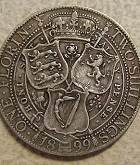
Edward VII
Both sides of the florin were redesigned following the accession of Victoria's son, Edward VII, each design being created by the Chief Engraver of the Royal Mint, George William de Saulles. The florin of King Edward VII was minted every year from 1902 to 1910. Its specifications remained at 11.3 grams weight and 28.5 millimetres diameter. The obverse shows the right-facing head of the King, inscribed EDWARDVS VII DEI GRA BRITT OMN REX FD IND IMP, while the other side features what Coincraft's Standard Catalogue of English and UK Coins deems "a most unusual and original reverse". It shows a windswept figure of Britannia standing holding a shield with her left hand and a trident with her right, and inscribed ONE FLORIN TWO SHILLINGS, with the date below. Peter Seaby, in his history of British coinage, described the figure of Britannia as "standing on some mythical ancient ship which could hardly be sea-worthy under her weight", but "a pleasing composition".
De Saulles created the new florin in this manner to distinguish the coin from the half crown, as there had been complaints of confusion. He probably based the design on his British trade dollar (1895). The sitter for the design was Susan Hicks-Beach, the daughter of Michael Hicks-Beach, 1st Earl St Aldwyn who had served as Chancellor of the Exchequer and ex officio Master of the Mint. The modern-day Britannia coinage, bullion pieces struck by the Royal Mint for investors and collectors, has a reverse that strongly resembles that of the Edwardian florin.
Florins bearing a left-facing effigy of George V by Sir Bertram Mackennal were minted in each year of the King's reign (1910–1936) except 1910 and 1934. The initial reverse design (1911–1926) was developed internally at the Royal Mint, and is intended to be that of the 1887 double florin, to which the Jubilee florin is very similar. The weight and diameter of the coin were unchanged but, because of rises in the price of silver, the metallic composition was changed in 1920 from 0.925 silver to 50% silver, 40% copper, 10% nickel, then again in 1922 to 50% silver, 50% copper, and again in 1927 to 50% silver, 40% copper, 5% nickel, 5% zinc. The changes in alloy after 1920 were due to the Mint's trying to find a silver alloy that would remain attractive as it wore. The inscriptions on the obverse of the original version of the George V florin were GEORGIVS V D G BRITT OMN REX F D IND IMP and on the reverse were ONE FLORIN and the year of striking.
The modified florin, dated 1927 to 1936, was designed by George Kruger Gray and did not greatly alter the design of shields and sceptres, but removed the crowns from the shields and placed them on the sceptres. A "G", the King's initial, is at the centre of the design. The obverse inscription became GEORGIVS V DEI GRA BRITT OMN REX and the reverse one was FID DEF IND IMP with the date and denomination ONE FLORIN. The bust of the King on the obverse was slightly modified in 1927.